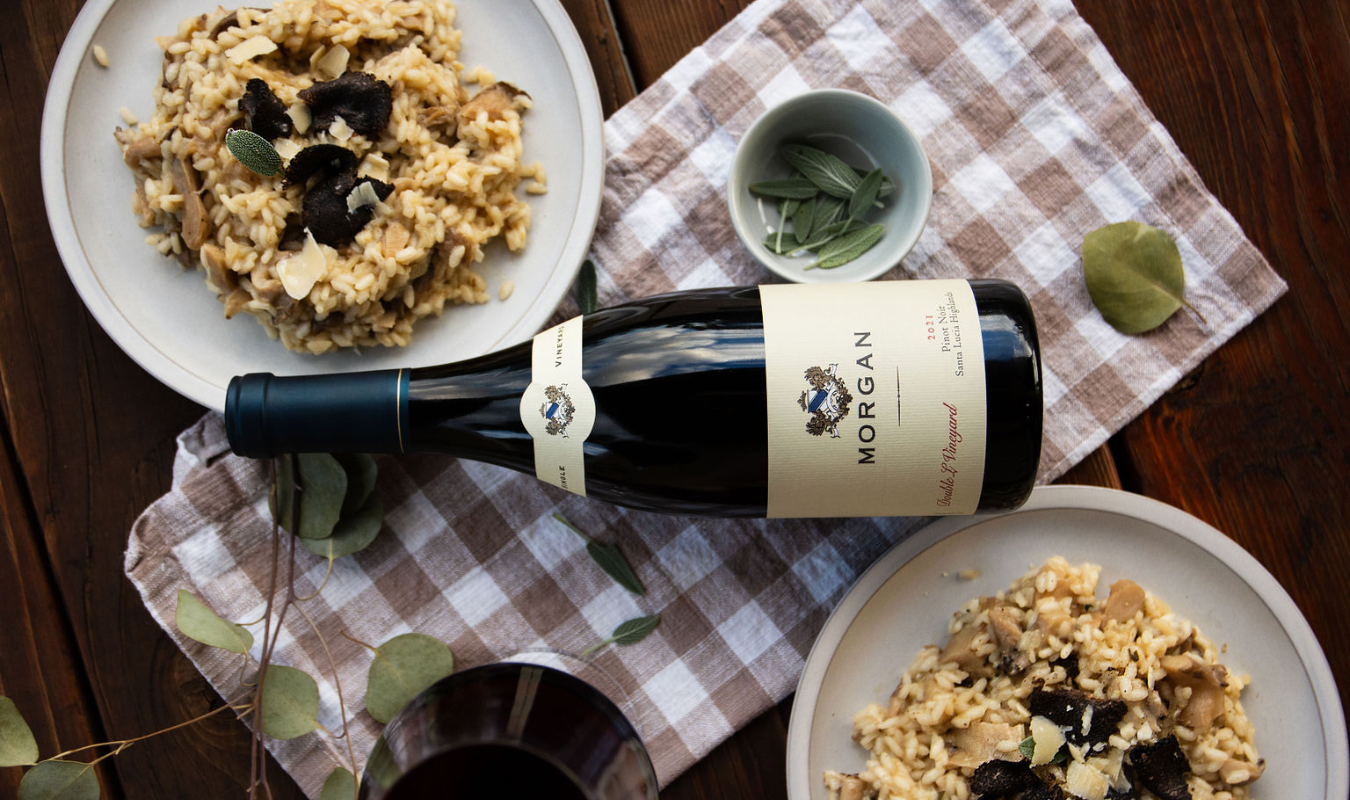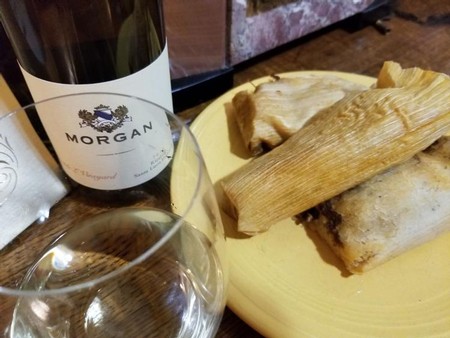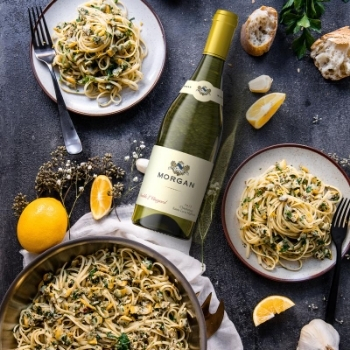Press
Truffle Mushroom Risotto Paired with Double L Vineyard Pinot Noir: A Match Made in Culinary Heaven

Indulge in a luxurious dining experience with this truffle-infused mushroom risotto, perfectly paired with our Double L Vineyard Pinot Noir. The rich and earthy flavors of the risotto beautifully complement the nuanced characteristics of the wine. As you savor each bite of the creamy risotto, enhanced by the umami-rich mushrooms and luxurious truffle aroma, you'll find the perfect harmony with the Pinot Noir's notes of red and dark fruits, subtle earthiness, and hints of spice. The silky mouthfeel of the wine complements the creamy texture of the risotto, creating a truly satisfying culinary experience. Treat yourself to this elegant pairing, ideal for a special evening or celebratory occasion.
Yield: 4 servings
Ingredients:
5 cups well-seasoned stock (vegetable, garlic, or seafood, based on preference)
Salt and freshly ground black pepper, to taste
2 tablespoons extra-virgin olive oil
2 shallots, finely diced
3/4 lb assorted mushrooms (maitake, shiitake, or wild mushrooms of choice)
3 garlic cloves, finely diced
6 fresh sage leaves
1 cup Arborio rice
1/3 cup non-aromatic white wine (Chardonnay is our go-to)
Freshly chopped parsley
1/2 cup freshly shaved Parmesan cheese
Fresh Perigord truffles
Instructions:
Begin by heating the stock in a pot, ensuring it is brought to a simmer and seasoned to perfection.
In a large saucepan, heat the extra-virgin olive oil over medium heat. Sauté the finely diced shallots until softened, approximately 5 minutes.
Increase the heat to high and add the assorted mushrooms. Stir and cook until they begin to release their natural juices. Introduce the finely diced garlic and fresh sage leaves, continuing to stir until fragrant. Season with salt and black pepper to elevate the flavors.
Incorporate the Arborio rice into the pan, stirring until the grains start to pop and become aromatic. Pour in the non-aromatic white wine, stirring until fully absorbed by the rice.
Begin the risotto cooking process by adding enough simmering stock to cover the rice. Reduce the heat to maintain a slow bubble and stir the mixture often. Continue this process until the stock is almost absorbed. Gradually add more stock, one or two ladles at a time, continuing to stir regularly. Repeat this step for 25-30 minutes or until the rice reaches the desired creamy consistency. Taste and season as needed while assessing the doneness of the rice, ensuring it is fully cooked yet maintains a delightful firmness.
Once the rice is perfectly cooked, add one final ladleful of stock, and stir in the freshly chopped parsley and Parmesan cheese. Remove the risotto from heat.
To elevate the dish, shave fresh Perigord truffles generously over each serving. Season with freshly cracked black pepper and serve immediately, garnished with fresh sage leaves and additional chopped parsley for a visually stunning and indulgent experience.
Pairing Off: Tamales versus Riesling

Monterey County Weekly
By Dave Faries
It’s the time of year when treasured family recipes are consulted, when there are siblings, cousins, aunts and uncles around to help with the tedious masa process, when you just give up and order tamales from a convenient location, in this case Mariscos Puerto Nuevo in Seaside.
Pairing wine with Christmas tamales is not so far-fetched, at least until salsa enters the fray.
“You want something with lots of fruit and mild tannins,” says Kerry Winslow, a wine educator working with Windy Oaks in Carmel Valley.
A heaping of fruit on the palate helps prevent the wine from capturing any bitterness from the tamale, in this case filled with shreds of pork. His options include Zinfandel and Carignan. Rosé is a more common choice.
But Winslow pivots away from red or a versatile Rosé.
“If you’re looking for a good local wine and want to do white, the off-dry Riesling from Morgan,” he adds with an expression of “Eureka!” on his face. “That would be fabulous.”
Now, a little etymological aside is in order here. You see, the word serendipity has had a hard life. For starters, a clever linguist derived it from a fairy tale. Just the sound of it is exceedingly precious.
To make matters worse, business consultants pounced on the concept, seeing in it a “principle of chance” that could be dangled before management for $650 an hour. One pundit held it up as a major Generation Y consumer trend for 2014.
Sorry times, indeed. But when I visited the Morgan Winery tasting room in Carmel to pick up a bottle, staff member Rafael Perez smiled broadly behind his mask.
His mother had done a tamale practice run the previous weekend. And guess which wine Perez had on hand? The 2020 Morgan Riesling, an organic, single vineyard bottling.
Yep. Serendipity.
The wine is fruity and floral on the nose, flaunting tart apple, but with a soft undertone of lemon and honey. A sip provides richer fruits—fresh cut peaches, skin peeled from a pear, honeysuckle and a trace of bitter zest. It’s elegant throughout, with a dry finish that subsides into must.
“It has a little natural sugar and good acidity,” Perez notes of the Kabinett-style Riesling. “It will cut through fat.”
Tamales from Mariscos Puerto Nuevo carry a rustic, natural sweetness in the masa. The pork is equally humble, with an earthy heft. Against this, the wine takes on a velvety feel—more opulent fruits, as if peaches had been baked down. Hints of whole orange and sliced apple emerge, along with a spicy tingle. The tamale benefits from the pairing, as well, gaining a soft, malty tone.
It’s a remarkable pairing that continues when the sauce is added. The Riesling flares momentarily, pricking the palate with cracks of black pepper that lends a rumble to the pork. When salsa is dabbed on, the wine responds nicely to the heat, raising its temperature a few notches before homing in on green pepper.
As Perez had told me, “it’s really good.”
The full article can be viewed by clicking here.
Linguine with Clam Sauce and Double L Chardonnay

This impressive dish comes together in just 15 minutes, but you’ll be talking about it for days. Perfectly al dente pasta is tossed in a silky sauce of white wine, butter, garlic, clams, and herbs. The dish is finished with a bright burst of lemon zest and juice plus lots of freshly chopped parsley for good measure.
Pair with 2017 Double L Chardonnay
Tasting Notes | Lemon curd, baking spices, and caramel aromas are echoed on the palate by Meyer lemon and salted butter toffee. One of the finest food wines, the organically farmed Double L Chardonnay will pair wonderfully with seafood and poultry dishes, as well as a buttery steak.
Ingredients
1 lb linguine pasta
2 tablespoons olive oil
5 garlic cloves - sliced
1/2 teaspoon red pepper flakes
1/2 cup dry white wine
2 - 10oz cans of whole baby clams, in juice
3 tablespoons butter
2 lemons - zested and juiced
1 bunch parsley - chopped
Directions
1. Cook the pasta: Bring a large pot of salted water to a boil and add the pasta, cooking according to the box’s directions and until al dente.
2. Make the sauce: Heat a large skillet over medium high heat and add the olive oil when hot. Add the garlic and red pepper flakes and cook for 2-3 minutes or until the garlic is aromatic and turns translucent. Make sure the garlic does not brown. Add the white wine and simmer until reduced by half. Next, add the clams and their juices and warm through for about 2 minutes. By this point, the pasta should be cooked. Drain the pasta, but reserve a cup of cooking water.
3. Finish the sauce: Add the pasta to the skillet along with the lemon zest, lemon juice, and butter. Toss the pasta in the pan continuously for 30 seconds as the butter melts. This will help the sauce become silky. Return the pan to heat and add a few tablespoons of the reserved pasta water as needed if the sauce is too thick. Taste the sauce and season with salt as needed. Add the chopped parsley and serve.
